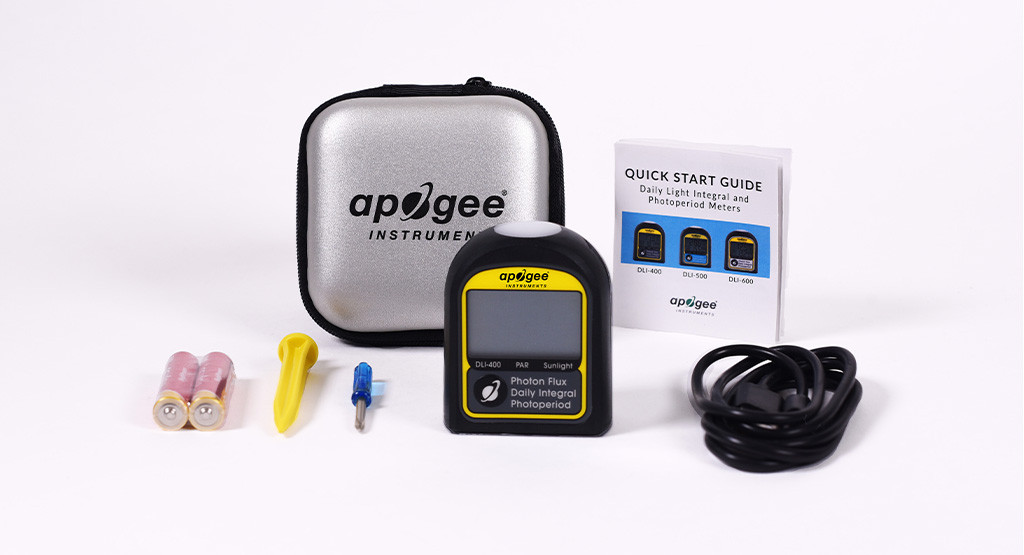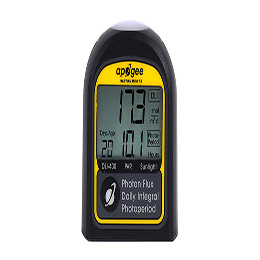Updated:2025-03-13
Views:1944
 WeChat
WeChat
 QQ
QQ
 Online Service
Online Service
 User's Manual
User's Manual
DLI-400 Daylight Meter:It is a new product in 2022, used to spot check the level of photosynthetically active radiation (PAR; 400 – 700 nm) and measure solar integration (DLI) and photoperiod. The DLI-400 is a low-cost option that is accurate only in sunlight and some broadband light sources. PAR, DLI and photoperiod affect plant growth and development. They are usually measured in greenhouses and growth chambers to help with light management and decision-making. DLI refers to the total amount of PAR or extended PAR (ePAR) incident on a plane within 24 hours, in moles per square meter per day. Photoperiod is the total incident time of PAR or ePAR within 24 hours, expressed in hours (h).







Accurate and stable measurement:Apogee research level quantum sensors have an accuracy drift rate of less than 2% per year, and all sensors are NIST traceable.
Measurement mode:This sturdy, waterproof and compact instrument is very suitable for single (spot check area) or continuous measurement of PPFD or ePPFD; DLI; And photoperiod. The DLI-400 instrument has two different screen modes to display measured values: storing data and viewing data in real time. In the Stored Data screen, it displays the DLI measurement, the optical period, and the date the data was collected (up to 99 days ago). The real-time view data screen displays the average value of PPFD operation in the last 2.5 seconds. Measuring and controlling DLI and the light time (photoperiod) received by plants is essential for optimizing plant health, triggering flowering and inducing other plant morphological effects. PPFD, DLI and photoperiod data can be viewed on the screen or downloaded via USB-C data line for analysis.
Rugged and ready to use:The DLI-400 is sturdy and durable, with the protection level of IP65, and can withstand harsh and humid environments. It can be carried around for spot check, placed directly on any horizontal surface, or connected to the commonly used camera tripod, fixture, or the standard used at the bottom ¼- 20 threaded ports. The DLI instrument consists of a cast acrylic diffuser (filter), an optical filter, a photodiode, a signal processing circuit, and an LCD display mounted in the ASA plastic housing.Each DLI package includes the instrument, a protective suitcase, two AAA batteries, a quick start guide, a screwdriver, a soil nail for easy installation, and a USB-C cable for downloading the data stored in the instrument to the computer as a CSV file.

| Calibration Uncertainty | ± 5 % |
| Measurement Repeatability | Less than 0.5 % |
| Display Range | 0 to 4000 µmol mˉ² sˉ¹ |
| Long-term Drift | Less than 2 % per year |
| Field of View | 180˚ |
| Spectral Measurement Range (± 5 nm) | 370 to 650 nm (sunlight only) |
| Directional (Cosine) Response | ± 5 % at 75˚ zenith angle |
| Temperature Response | -0.04 % per ℃ |
| Response Time | 2.5 seconds |
| Measurement Frequency | 3 minutes |
| Data Log Capacity | 99 days (DLI & Photoperiod), 10 days (30 min PPFD/ePPFD averages) |
| Non-linearity | Less than 1 % (up to 2500 µmol mˉ² sˉ¹) |
| Stored Data Resolution (PPFD) | 0.1 µmol mˉ² sˉ¹ (when ≥ 1000, the screen will not display the decimal) |
| Stored Data Resolution (DLI) | 0.1 mol mˉ² dˉ¹ |
| Stored Data Resolution (Photoperiod) | 0.1 hours |
| Connectivity | CSV file via USB-C data transfer |
| ADC Resolution | 24 bits |
| Operating Environment | -10 to 60 ℃ ; 0 to 100 % relative humidity |
| Ingress Protection | IP65 |
| Mounting Compatibility | Brass 1/4-20 threaded mount |
| Battery Life | Approximately 6 months |
| Dimensions | 1.91 W x 2.31 H x 0.93 D (inches) |
| Mass | 67 g |
| Warranty | 4 years against defects in materials and workmanship |
| Manufactured | Made in the USA |
Customer Service QQ
Customer Hotline:
Technical Supports